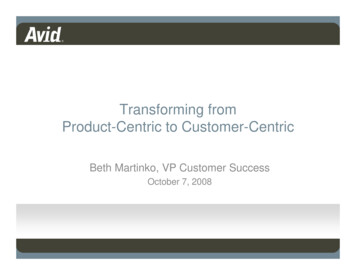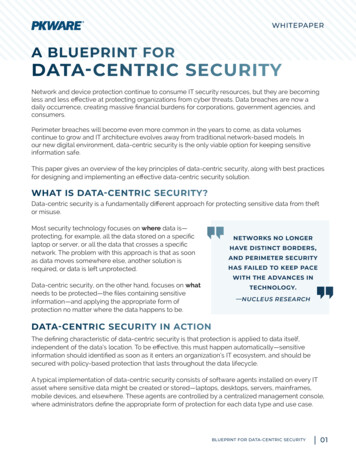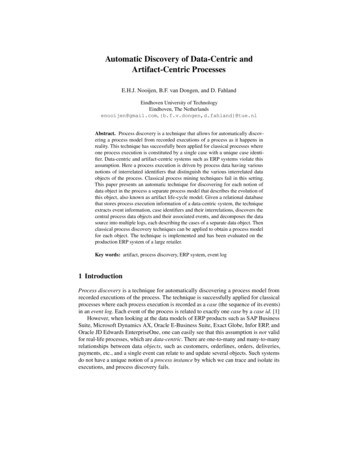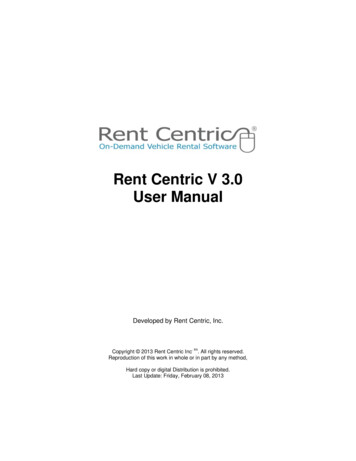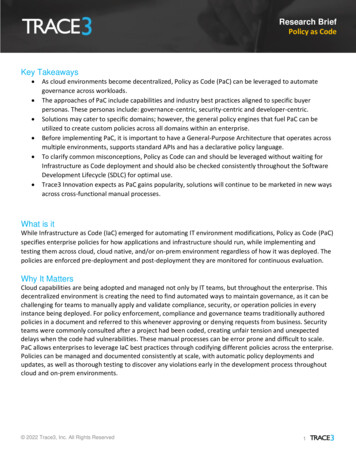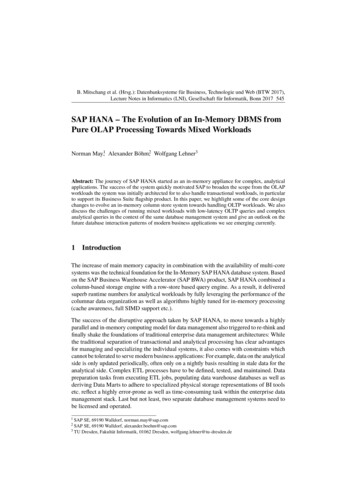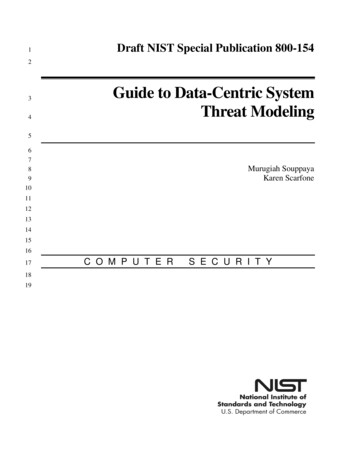
Transcription
1Draft NIST Special Publication 800-154234Guide to Data-Centric SystemThreat Modeling5678910Murugiah SouppayaKaren Scarfone111213141516171819C O M P U T E RS E C U R I T Y
20Draft NIST Special Publication 800-1542122232425Guide to Data-Centric SystemThreat 4748495051Murugiah SouppayaComputer Security DivisionInformation Technology LaboratoryKaren ScarfoneScarfone CybersecurityClifton, VAMarch 2016U.S. Department of CommercePenny Pritzker, SecretaryNational Institute of Standards and TechnologyWillie May, Under Secretary of Commerce for Standards and Technology and Director
52Authority53545556575859This publication has been developed by NIST in accordance with its statutory responsibilities under theFederal Information Security Modernization Act (FISMA) of 2014, 44 U.S.C. § 3541 et seq., Public Law(P.L.) 113-283. NIST is responsible for developing information security standards and guidelines,including minimum requirements for federal information systems, but such standards and guidelines shallnot apply to national security systems without the express approval of appropriate federal officialsexercising policy authority over such systems. This guideline is consistent with the requirements of theOffice of Management and Budget (OMB) Circular A-130.606162636465Nothing in this publication should be taken to contradict the standards and guidelines made mandatoryand binding on federal agencies by the Secretary of Commerce under statutory authority. Nor shouldthese guidelines be interpreted as altering or superseding the existing authorities of the Secretary ofCommerce, Director of the OMB, or any other federal official. This publication may be used bynongovernmental organizations on a voluntary basis and is not subject to copyright in the United States.Attribution would, however, be appreciated by NIST.666768National Institute of Standards and Technology Special Publication 800-15469707172Certain commercial entities, equipment, or materials may be identified in this document in order to describe anexperimental procedure or concept adequately. Such identification is not intended to imply recommendation orendorsement by NIST, nor is it intended to imply that the entities, materials, or equipment are necessarily the bestavailable for the purpose.737475767778There may be references in this publication to other publications currently under development by NIST inaccordance with its assigned statutory responsibilities. The information in this publication, including concepts andmethodologies, may be used by federal agencies even before the completion of such companion publications. Thus,until each publication is completed, current requirements, guidelines, and procedures, where they exist, remainoperative. For planning and transition purposes, federal agencies may wish to closely follow the development ofthese new publications by NIST.798081Organizations are encouraged to review all draft publications during public comment periods and provide feedbackto NIST. Many NIST cybersecurity publications, other than the ones noted above, are available athttp://csrc.nist.gov/publications.Natl. Inst. Stand. Technol. Spec. Publ. 800-154, 25 pages (March 2016)CODEN: NSPUE28283Public comment period: March 14, 2016 through April 15, 201684All comments are subject to release under the Freedom of Information Act (FOIA).85868788National Institute of Standards and TechnologyAttn: Computer Security Division, Information Technology Laboratory100 Bureau Drive (Mail Stop 8930) Gaithersburg, MD 20899-8930Email: 800-154comments@nist.gov89i
90Reports on Computer Systems Technology919293949596979899The Information Technology Laboratory (ITL) at the National Institute of Standards and Technology(NIST) promotes the U.S. economy and public welfare by providing technical leadership for the Nation’smeasurement and standards infrastructure. ITL develops tests, test methods, reference data, proof ofconcept implementations, and technical analyses to advance the development and productive use ofinformation technology. ITL’s responsibilities include the development of management, administrative,technical, and physical standards and guidelines for the cost-effective security and privacy of other thannational security-related information in federal information systems. The Special Publication 800-seriesreports on ITL’s research, guidelines, and outreach efforts in information system security, and itscollaborative activities with industry, government, and academic 09Threat modeling is a form of risk assessment that models aspects of the attack and defense sides of aparticular logical entity, such as a piece of data, an application, a host, a system, or an environment. Thispublication examines data-centric system threat modeling, which is threat modeling that is focused onprotecting particular types of data within systems. The publication provides information on the basics ofdata-centric system threat modeling so that organizations can successfully use it as part of their riskmanagement processes. The general methodology provided by the publication is not intended to replaceexisting methodologies, but rather to define fundamental principles that should be part of any sound datacentric system threat modeling methodology.110111112113Keywordsdata security; information security; risk assessment; risk management; threat modeling; threats;vulnerabilities114115116Trademark InformationAll trademarks or registered trademarks belong to their respective organizations.117118119120121AcknowledgmentsThe authors, Murugiah Souppaya of the National Institute of Standards and Technology (NIST) andKaren Scarfone of Scarfone Cybersecurity, wish to thank their colleagues who reviewed drafts of thisdocument and contributed to its technical content.122ii
123Table of Contents124Executive Summary . 11251.1.11.21.3126127128129Introduction . 22.Attack and Defense Basics . 32.1130131132133134135136137138Purpose and Scope .2Audience .2Document Structure .22.2The Attack Side .32.1.1 Vulnerability . 32.1.2 Exploit and Attack . 42.1.3 Attack Vector. 52.1.4 Threat . 6The Defense Side.72.2.1 Risk . 72.2.2 Security Controls . 72.2.3 Security Objectives . 71393.Introduction to System and Data-Centric System Threat Modeling . 91404.Basics of Data-Centric System Threat Modeling .111411421431441451464.14.24.34.44.5Step 1: Identify and Characterize the System and Data of Interest . 11Step 2: Identify and Select the Attack Vectors to Be Included in the Model . 13Step 3: Characterize the Security Controls for Mitigating the Attack Vectors . 14Step 4: Analyze the Threat Model .16Customizing the Data-Centric System Threat Modeling Approach . 17147List of Appendices148Appendix A— Acronyms and Other Abbreviations .19149Appendix B— References .20150151iii
NIST SP 800-154 (DRAFT)GUIDE TO DATA-CENTRIC SYSTEM THREAT MODELING152Executive Summary153154155156157158159160Threat modeling is a form of risk assessment that models aspects of the attack and defense sides of aparticular logical entity, such as a piece of data, an application, a host, a system, or an environment. Thefundamental principle underlying threat modeling is that there are always limited resources for securityand it is necessary to determine how to use those limited resources effectively. There are many types ofthreat modeling; for example, system threat modeling is threat modeling performed for operationalsystems to improve their overall security. This publication focuses on one type of system threat modeling:data-centric system threat modeling. Data-centric system threat modeling is threat modeling that isfocused on protecting particular types of data within systems.161162163164165166167Threat modeling is needed because of the dynamic nature of security. The attack and defense sides ofsecurity are constantly changing. As part of handling this change, organizations should continuallyreassess and evolve their defenses. This includes adopting continuous monitoring practices, securityautomation technologies, and threat intelligence feeds to detect new vulnerabilities and attacks in nearreal-time, allowing rapid risk mitigation. Another key component of handling the constant change insecurity is having security metrics; these can be used for more informed decision making, again oftenrelating to risk management in general and risk mitigation in particular.168169170171172173174175Increasingly, simply following general “best practices” for security is insufficient for safeguarding highvalue data. Best practices are largely based on conventional wisdom intended to mitigate common threatsand vulnerabilities. By their very nature, such best practices are generalized, especially for ubiquitousproducts (web browsers, server and desktop operating systems, etc.) They do not take into account theunique characteristics of each system. Also, most best practices are geared toward preventing hostcompromise and do not take into account the security needs for particular data (again, a more generalizedgoal versus a specific one). So, for a particular situation, best practices may not include security controlsthat are necessary to effectively reduce risk.176177178179180Data-centric system threat modeling allows organizations to consider the security needs of each case ofinterest, instead of relying solely on generalized “best practice” recommendations. Organizations withstrong capabilities in continuous monitoring, security automation, and security metrics should consideradding data-centric system threat modeling based on the principles presented in this publication tosupplement these capabilities and achieve demonstrably better security for data of particular importance.1811
NIST SP 800-154 (DRAFT)GUIDE TO DATA-CENTRIC SYSTEM THREAT MODELING1821.Introduction1831.1Purpose and Scope184185186187Organizations often plan, implement, maintain, and assess the security controls for their systems withoutperforming a methodical analysis of risk involving system threat modeling. The purpose of thispublication is to provide information on the basics of system threat modeling so that organizations cansuccessfully use it as part of their risk management processes.188189190191There are many forms of threat modeling. This publication’s scope is limited to data-centric system threatmodeling, which involves focusing on the security of particular instances of data (such as clientinformation stored on a field agent’s laptop) instead of focusing on the security of particular hosts,operating systems (OS), applications, etc.192193194This publication provides a general methodology that organizations can use. The intent is not to replaceexisting methodologies, but rather to define fundamental principles that should be part of any sound datacentric system threat modeling methodology.1951.2196197198199This document is intended for security managers, security engineers/architects, system administrators, andothers who are responsible for planning, implementing, and maintaining data and system securitycontrols. Auditors and others who need to assess the security of data and systems may also find thispublication useful.2001.3201The remainder of this document is organized into the following major sections and appendices:AudienceDocument Structure202203 Section 2 discusses attack and defense basics. The terminology and concepts defined in thissection are fundamental to understanding the rest of the publication.204 Section 3 provides an introduction to general system threat modeling.205206 Section 4 presents a basic methodology for data-centric system threat modeling, with simplifiedexamples illustrating the use of the methodology.207 Appendix A contains an acronym and abbreviation list.208 Appendix B lists the references for the document.2092
NIST SP 800-154 (DRAFT)GUIDE TO DATA-CENTRIC SYSTEM THREAT MODELING2102.Attack and Defense Basics211212213214215216This section establishes a foundation for the rest of the document by covering the basic concepts ofsecurity relevant to threat modeling. It defines fundamental terminology, such as what vulnerabilities andattack vectors are, because of the lack of consensus in the security community as to what such termsmean. It also explains how these concepts work in practice. The discussion is divided into two parts: theattack side (Section 2.1) and the defense side (Section 2.2). This section can be thought of as explainingthe problem that threat modeling is trying to solve. The term “threat modeling” is defined in Section 3.2172.1218219220221222This section defines the basic concepts related to the attack side of threat modeling, grouped by coreterms: vulnerability, exploit and attack, attack vector, and threat. Where applicable, it enumerates themajor categories of each entity (such as major categories of vulnerabilities). These enumerations are notintended to be comprehensive or authoritative, but instead to help illustrate the potential scope of threatmodeling activities.2232.1.1224225226The term “vulnerability” has been defined in many ways over years. This document proposes that avulnerability is any trust assumption involving people, processes, or technology that can be violated inorder to exploit a system. Types of vulnerabilities include the following:The Attack SideVulnerability227228229230231232 A software flaw vulnerability is caused by an error in the design or coding of software. Oneexample is an input validation error, such as user-provided input being trusted, and thus not beingproperly evaluated for malicious character strings and overly long values associated with knownattacks. Another example is a race condition error that allows the attacker to perform a specificaction with elevated privileges. A race condition is possible because the software does not expectcertain patterns of activity to occur, in effect trusting that users will not cause such patterns.233234235236237238239240 A security configuration issue vulnerability involves the use of security configuration settingsthat negatively affect the security of the software if taken advantage of by users. A securityconfiguration setting is an element of a software’s security that can be altered through thesoftware itself. Examples of settings are an operating system offering access control lists that setuser privileges for files, and an application offering a setting to enable or disable the encryptionof sensitive data stored by the application. Many configuration settings increase security at theexpense of reducing functionality, so using the most secure settings could make the softwareuseless or unusable.241242243244245246247248249250251252253 A software feature is a functional capability provided by software. A software feature misusevulnerability is a vulnerability in which the feature also provides an avenue to compromise thesecurity of a system. These vulnerabilities are caused by the software designer making trustassumptions that permit the software to provide beneficial features, while also introducing thepossibility of someone violating the trust assumptions to compromise security. For example,email client software may contain a feature that renders HTML content in email messages. Anattacker could craft a fraudulent email message that contains hyperlinks that, when rendered inHTML, appear to the recipient to be benign, but actually take the recipient to a malicious web sitewhen they are clicked on. One of the trust assumptions in the design of the HTML contentrendering feature was that users would not receive malicious hyperlinks and click on them.Another example of a software feature misuse vulnerability is an attacker stealing a user’scredentials and reusing them to impersonate the user; the trust assumption was that only thelegitimate user would use those credentials. Misuse vulnerabilities are inherent in software3
NIST SP 800-154 (DRAFT)GUIDE TO DATA-CENTRIC SYSTEM THREAT MODELING254255features because each feature is based on trust assumptions—and those assumptions can bebroken, albeit involving significant cost and effort in some cases. [1]256257258259260261262No system is 100 percent secure: every system has vulnerabilities. At any given time, a system may nothave any known software flaws, but security configuration issues and software feature misusevulnerabilities are always present and cannot even be readily enumerated at this time. A system’svulnerabilities are likely to have a wide variety of characteristics. Some will be very easy to exploit, whileothers will only be exploitable under a combination of highly unlikely conditions. One vulnerabilitymight provide root-level access to a system, while another vulnerability might only permit read access toan insignificant file.2632.1.2264265266267268269270271To exploit a vulnerability is to use it to violate security objectives, such as confidentiality, integrity, andavailability (see Section 2.2.3 for more information on security objectives). The program code or othercommands used to exploit a vulnerability are generically referred to as an exploit or an attack. Thesemeanings, which are specific to the commands, are not to be confused with the verb forms of “exploit”and “attack”, which have different meanings; “to exploit” implies a successful security violation, while“to attack” implies an attempted security violation but not its success or failure. Noun forms of theseverbs, referring to the actions, have the same distinction in meanings; an attack (action) that succeeds canalso be called an exploit.272273274275276277This document uses the term attacker to refer to a party who attacks a host, network, or other IT resource.However, not all attacks are intentional. Some attacks are performed by users who accidentally orotherwise unintentionally violate security policies, requirements, etc., to the point of compromisingsecurity. Because intent often has no relation to the impact of a compromise, this document uses the term“attack” to refer to both intentional and inadvertent compromises. Sections 2.1.2.1 and 2.1.2.2 discuss theindividuals who perform attacks in both categories.2782.1.2.1 Intentional279280281282283284Attackers who intend to exploit vulnerabilities are motivated by various reasons, ranging from the desireto make political or social statements to financial gain and cyberwarfare. Some attackers are focused on ashort-term action, such as a financial transaction, but many attackers, especially those interested ingaining access to sensitive information, may be more interested in long-term infiltration and datagathering. These attacks are often targeted, such as focusing on exploiting a high-value system orindividual.285286287288289290291292The skill sets of attackers vary as widely as their motivations. At one extreme are unskilled individualswho purchase attack toolkits that make basic exploitation almost trivial to perform. At the other extremeare highly skilled individuals who are capable of discovering new vulnerabilities on their own andfiguring out how to exploit them. Another important group of attackers to consider is malicious insiders;even though they may not be particularly skilled in exploitation, their level of access and detailedknowledge of the organization’s systems makes them particularly effective at data theft and manipulation.A malicious insider may also work in conjunction with an external attacker, such as insiders selling theirusernames and passwords to third parties.293294295296Another category of intentional attacks is not directly associated with a particular person or group—forexample, malware may have been propagating from system to system for some time and is not beingdirected or otherwise controlled by anyone. This is not meant to imply that no one is responsible for themalware, but rather that there is not a person specifically launching each instance of the malware.Exploit and Attack4
NIST SP 800-154 (DRAFT)GUIDE TO DATA-CENTRIC SYSTEM THREAT MODELING297298Because the malware is designed to exploit vulnerabilities, this publication considers all malware-basedattacks to be intentional attacks.2992.1.2.2 Inadvertent300301302Attackers who inadvertently exploit vulnerabilities are acting either by accident or through a lack ofunderstanding, such as performing actions that they do not know are security violations or do not considera “real” security problem.3032.1.3304305306307An attack vector is a segment of the entire pathway that an attack uses to access a vulnerability. Eachattack vector can be thought of as comprising a source of malicious content, a potentially vulnerableprocessor of that malicious content, and the nature of the malicious content itself. Examples of attackvectors are:Attack Vector308309 Malicious web page content (content) downloaded from a web site (source) by a vulnerable webbrowser (processor);310311 A malicious email attachment (content) in an email client (source) rendered by a vulnerablehelper application (processor);312313 A malicious email attachment (content) downloaded from an email server (source) to a vulnerableemail client (processor);314315 A network service with inherent vulnerabilities (processor) used maliciously (content) by anexternal endpoint (source);316317 Social engineering-based conversation (content) performed by phone from a human attacker(source) to get a username and password from a vulnerable user (processor);318319 Stolen user credentials (content) typed in by an attacker (source) to a web interface for anenterprise authentication system (processor); and320321322 Personal information about a user harvested from social media (content) entered into a passwordreset website by an attacker (source) to reset a password by taking advantage of weak passwordreset processes (processor).323324325326327The characteristics of attacks vary widely. Some involve exploitation of a single vulnerability using asingle attack vector, while others involve multiple vulnerabilities and multiple attack vectors, or even asingle vulnerability and multiple attack vectors. And the vulnerabilities and attack vectors may be spreadacross multiple hosts, compromising one host in order to compromise another, further complicating thecomposition of an attack.328329Here is an example of a single possible attack involving one vulnerability, decomposed into its attackvectors:3303311. Malicious email attachment (content) sent from a host (source) to the organization’s primary mailserver (processor);5
NIST SP 800-154 (DRAFT)GUIDE TO DATA-CENTRIC SYSTEM THREAT MODELING3323332. Malicious email attachment (content) sent from the organization’s primary mail server (source) toantivirus server (processor);3343353. Malicious email attachment (content) sent from the antivirus server (source) to the organization’sinternal mail server (processor);3363374. Malicious email attachment (content) sent from the organization’s internal mail server (source) tothe user’s email client (processor); and3383395. Malicious email attachment (content) rendered (processor) by the vulnerable email client(source).340341342Note that although there are five attack vectors, the actual exploitation only occurs during the last of thefive (when the malicious attachment is rendered by a vulnerable email client). However, each attackvector affords an opportunity to detect and stop the attack before it goes any farther.343344345346347348Although this example focuses on vulnerabilities in technologies, many attacks include non-technologicalattack vectors. For example, attackers often use social engineering methods to trick users into revealingtheir passwords, performing actions that unknowingly grant attackers remote access to systems, andotherwise enabling security to be compromised. Similar attacks may be performed on IT personnel, suchas an attacker impersonating a legitimate user and convincing a help desk agent to reset the user’spassword to a password selected by the attacker.349350351352353354355356Because the focus of this publication is modeling threats against a targeted (vulnerable) system, thecompromises of greatest interest are those against the ultimate target itself. There are often intermediatehosts used as jumping off points for attacks—in botnets, for example. Analyzing how those intermediatehosts become compromised would fall within the scope of performing an analysis of those individualintermediate hosts themselves as targets, and is outside the scope of analyzing the ultimate target. So, inthe previous example with five attack vectors, with the ultimate target being the host with the vulnerableemail client, it would be irrelevant to the target how the host in step 1 that originally sent the maliciousemail attachment was compromised.357358359360361Other terms are useful when discussing attack vectors. For example, an attack model comprises a scenariothat may occur and a single path (one or more attack vectors in sequence) that could be taken for thatscenario. The attack models for a scenario and the security controls attempting to disrupt those attackmodels collectively constitute a threat model. 1 Another way to analyze attack vectors is to analyze all ofthe attack vectors directly against a particular system; this is known as the system’s attack surface.3622.1.4363364365366367368369A threat is defined in NIST Special Publication (SP) 800-30 as “any circumstance or event with thepotential to adversely impact organizational operations and assets, individuals, other organizations, or theNation through an information system via unauthorized access, destruction, disclosure, or modification ofinformation, and/or denial of service.” [2, p. B-13] Threats may be intentional or unintentional. A threatsource is the cause of a threat, such as a hostile cyber or physical attack, a human error of omission orcommission, a failure of organization-controlled hardware or software, or other failure beyond the controlof the organization.1ThreatSection 3 contains a more formal definition of the term “threat modeling.”6
NIST SP 800-154 (DRAFT)GUIDE TO DATA-CENTRIC SYSTEM THREAT MODELING370371372373A threat event is defined in NIST SP 800-30 as “an event or situation initiated or caused by a threatsource that has the potential for causing adverse impact.” [2, p. B-13] The distinction between a threat anda threat event is subtle, but basically a threat event is caused by a particular threat source, while a threat ismore generic (not caused by a particular threat source).3742.2375376This section explains the basic concepts related to the defense side of threat modeling, grouped by coreterms: risk, security controls, and security ee on National Security Systems Instruction (CNSSI) 4009, National Information Assurance (IA)Glossary, defines risk in general as “a measure of the extent to which an entity is threatened by a potentialcircumstance or event, and typically a function of: (i) the adverse impacts that would arise if thecircumstance or event occurs; and (ii) the likelihood of occurrence” [3, p. 104] and information securityrisks specifically as “those risks that arise from the loss of confidentiality, integrity, or availability ofinformation or information systems and reflect the potential adverse impacts to organizational operations(including mission, functions, image, or reputation), organizational assets, individuals, otherorganizations, and the Nation” [3, p. 65].386387388389390391392393Risk management is defined in CNSSI 4009 as “the program and supporting processes to manageinformation security risk to organizational operations .” [3, p. 104]. Part of risk management is riskassessment, which is defined in NIST SP 800-30 as “the process of identifying, prioritizing, andestimating risks to organizational operations (including mission, functions, image, reputation),organizational assets, individuals, other organizations, and the Nation, resulting from
169 value data. Best practices are largely based on conventional wisdom intended to mitigate common threats 170 and vulnerabilities. By their very nature, such best practices are generalized, especially for ubiquitous . 179 adding data-centric system threat modeling based on the principles presented in this publication to 180 .

